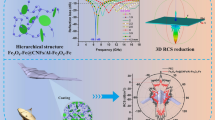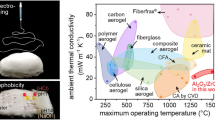Abstract
A mild-temperature, nonchemical technique is used to produce a nanohybrid multifunctional (electro-conducting and magnetic) powder material by intercalating iron oxide nanoparticles in large aspect ratio, open-ended, hollow-core carbon nanofibers (CNFs). Single-crystal, superparamagnetic Fe3O4 nanoparticles (10 nm average diameter) filled the CNF internal cavity (diameter <100 nm) after successive steps starting with dispersion of CNFs and magnetite nanoparticles in aqueous or organic solvents, sequencing or combining sonication-assisted capillary imbibition and concentration-driven diffusion, and finally drying at mild temperatures. The influence of several process parameters—such as sonication type and duration, concentration of solids dispersed in solvent, CNF-to-nanoparticle mass ratio, and drying temperature—on intercalation efficiency (evaluated in terms of particle packing in the CNF cavity) was studied using electron microscopy. The magnetic CNF powder was used as a low-concentration filler in poly(methyl methacrylate) to demonstrate thin free-standing polymer films with simultaneous magnetic and electro-conducting properties. Such films could be implemented in sensors, optoelectromagnetic devices, or electromagnetic interference shields.








Similar content being viewed by others
References
Ajayan PM, Iijima S (1993) Capillarity-induced filling of carbon nanotubes. Nature 361:333–334
Al-Saleh MH, Sundararaj U (2009) A review of vapor grown carbon nanofiber/polymer conductive composites. Carbon 47:2–22
Bachtold A, Hadley P, Nakanishi T, Dekker C (2001) Logic circuits with carbon nanotube transistors. Science 294:1317–1320
Bazilevsky AV, Sun K, Yarin AL, Megaridis CM (2007) Selective intercalation of polymers in carbon nanotubes. Langmuir 23:7451–7455
Bazilevsky AV, Sun K, Yarin AL, Megaridis CM (2008) Room-temperature, open-air, wet intercalation of liquids, surfactants, polymers and nanoparticles within nanotubes and microchannels. J Mater Chem 18:696–702
Brune H, Ernst H, Grunwald A, Grünwald W (2006) Nanotechnology: assessment and perspectives. Eth Sci Technol Assess vol 27, Springer, Berlin Heidelberg
Castillejos E, Debouttière P-J, Roiban L et al (2009) An efficient strategy to drive nanoparticles into carbon nanotubes and the remarkable effect of confinement on their catalytic performance. Angew Chem Int Ed Engl 48:2529–2533
Chamberlain TW, Popov AM, Knizhnik AA et al (2010) The role of molecular clusters in the filling of carbon nanotubes. ACS Nano 4:5203–5210
Charlier J, Lambin P, Ebbesen T (1996) Electronic properties of carbon nanotubes with polygonized cross sections. Phys Rev B 54:R8377–R8380
Cheng H, Qiu H, Zhu Z et al (2012) Investigation of the electrochemical behavior of dopamine at electrodes modified with ferrocene-filled double-walled carbon nanotubes. Electrochim Acta 63:83–88
Chou SY, Wei MS, Krauss PR, Fischer PB (1994) Single-domain magnetic pillar array of 35 nm diameter and 65 Gbits/in. 2 density for ultrahigh density quantum magnetic storage. J Appl Phys 76:6673–6675
Chu A, Cook J, Heesom RJR et al (1996) Filling of carbon nanotubes with silver, gold, and gold chloride. Chem Mater 8:2751–2754
Costa PMFJ, Coleman KS, Green MLH (2005) Influence of catalyst metal particles on the hydrogen sorption of single-walled carbon nanotube materials. Nanotechnology 16:512–517
Dai H, Kong J, Zhou C et al (1999) Controlled chemical routes to nanotube architectures, physics, and devices. J Phys Chem B 103:11246–11255
Day TM, Unwin PR, Wilson NR, Macpherson JV (2005) Electrochemical templating of metal nanoparticles and nanowires on single-walled carbon nanotube networks. J Am Chem Soc 127:10639–106447
Day TM, Unwin PR, Macpherson JV (2007) Factors controlling the electrodeposition of metal nanoparticles on pristine single walled carbon nanotubes. Nano Lett 7:51–57
Demoncy N, St O, Brun N et al (1998) Filling carbon nanotubes with metals by the arc-discharge method: the key role of sulfur. Eur Phys J B 4:147–157
Dong X, Fu D, Ahmed MO et al (2007) Heme-enabled electrical detection of carbon monoxide at room temperature using networked carbon nanotube field-effect transistors. Chem Mater 19:6059–6061
Dong X, Lau CM, Lohani A et al (2008) Electrical detection of femtomolar DNA via gold-nanoparticle enhancement in carbon-nanotube-network field-effect transistors. Adv Mater 20:2389–2393
Dresselhaus M., Dresselhaus G., Avouris P. (2001) Carbon Nanotubes: Synthesis, Properties and Applications. Top Appl Phys, vol 80. Springer, Berlin
Ebbesen W (1996) Wetting, filling and decorating. J Phys Chem Solids 57:951–955
Erb RM, Libanori R, Rothfuchs N, Studart AR (2012) Composites reinforced in three dimensions by using low magnetic fields. Science 335:199–204
Fragouli D, Buonsanti R, Bertoni G et al (2010) Dynamical formation of spatially localized arrays of aligned nanowires anisotropy. ACS Nano 4:1873–1878
Fragouli D, Das A, Innocenti C, Guttigonta Y, Rahman S, Liu L, Caramia V, Megaridis CM, Athanassiou A (2014) Polymeric films with electric and magnetic anisotropy due to magnetically assembled functional nanofibers. ACS Appl Mater Interfaces 6:4535–4541
Gautam UK, Costa PMFJ, Bando Y et al (2010) Recent developments in inorganically filled carbon nanotubes: successes and challenges. Sci Technol Adv Mater 11:054501
Goldstein AN, Echer CM, Alivisatos AP (1992) Melting in semiconductor nanocrystals. Science 256:1425–1427. doi:10.1126/science.256.5062.1425
Guan L, Shi Z, Li M, Gu Z (2005) Ferrocene-filled single-walled carbon nanotubes. Carbon 43:2780–2785
Guerretpiecourt C, Le bouar Y, Loiseau A, Pascard H (1994) Relation between metal electronic structure and morphology of metal compounds inside carbon nanotubes. Nature 372:761–765
Kornev KG, Halverson D, Korneva G et al (2008) Magnetostatic interactions between carbon nanotubes filled with magnetic nanoparticles. Appl Phys Lett 92:233117
Korneva G, Ye H, Gogotsi Y et al (2005) Carbon nanotubes loaded with magnetic particles. Nano Lett 5:879–884
Kuzmany H, Fink J, Mehring M, Roth S (2001) Nanotube. Electronic properties of molecular nanostructures. AIP-Press, Springer, New York, pp 562–567
La Torre A, Rance GA, El Harfi J et al (2010) Transport and encapsulation of gold nanoparticles in carbon nanotubes. Nanoscale 2:1006–1010
La Torre A, Fay MW, Rance GA et al (2012) Interactions of gold nanoparticles with the interior of hollow graphitized carbon nanofibers. Small 8:1222–1228
Lee J, Park J, Kim J, Yi W (2008) Efficient visible photoluminescence from encapsulation of fluorescent materials inside single-walled carbon nanotubes. Colloids Surf A 313–314:296–299
Li L-J, Khlobystov AN, Wiltshire JG et al (2005) Diameter-selective encapsulation of metallocenes in single-walled carbon nanotubes. Nat Mater 4:481–485
Liu C, Fan YY, Liu M et al (1999) Hydrogen storage in single-walled carbon nanotubes at room temperature. Science 286:1127–1129
Luo J, Mark LP, Giannakopulos AE et al (2011) Field ionization using densely spaced arrays of nickel-tipped carbon nanotubes. Chem Phys Lett 505:126–129
Misewich JA, Martel R, Avouris P, Tsang JC, Heinze S, Tersoff J (2003) Electrically induced optical emission from a carbon nanotube FET. Science 300:783–786
Mönch I, Meye A, Leonhardt A et al (2005) Ferromagnetic filled carbon nanotubes and nanoparticles: synthesis and lipid-mediated delivery into human tumor cells. J Magn Magn Mater 290–291:276–278
Okazaki T, Suenaga K, Hirahara K et al (2001) Communications to the editor. J Am Chem Soc 123:9673–9674
Palaniselvam T, Kannan R, Kurungot S (2011) Facile construction of non-precious iron nitride-doped carbon nanofibers as cathode electrocatalysts for proton exchange membrane fuel cells. Chem Commun 47:2910–2912
Pan X, Bao X (2008) Reactions over catalysts confined in carbon nanotubes. Chem Commun (Camb) 47:6271–6281
Pati SP, Bhushan B, Das D (2010) Exchange interaction at the interface of Fe–NiO nanocomposites. J Solid State Chem 183:2903–2909
Pati SP, Kumar S, Das D (2012) Memory effects in exchange coupled Fe/Co3O4 nanocomposites. Mater Chem Phys 137:303–309
Qiu H, Shi Z, Zhang S et al (2006) Synthesis and Raman scattering study of double-walled carbon nanotube peapods. Solid State Commun 137:654–657
Sinha-Ray S, Sahu RP, Yarin AL (2011) Nano-encapsulated smart tunable phase change materials. Soft Matter 7:8823–8827
Sloan J, Wright DM, Woo H-G et al (1999) Capillarity and silver nanowire formation observed in single walled carbon nanotubes. Chem Commun 8:699–700
Smith BW, Monthioux M, Luzzi DE (1998) Encapsulated C60 in carbon nanotubes. Nature 396:323–324
Smith BW, Monthioux M, Luzzi DE (1999) Carbon nanotube encapsulated fullerenes: a unique class of hybrid materials. Chem Phys Lett 315:31–36
Sutradhar S, Mukhopadhyay K, Pati S, Das S, Das D, Chakrabarti PK (2013) Modulated magnetic property, enhanced microwave absorption and Mössbauer spectroscopy of Ni0.40Zn0.40Cu0.20Fe2O4 nanoparticles embedded in carbon nanotubes. J Alloys Compd 576:126–133
Takenobu T, Takano T, Shiraishi M et al (2003) Stable and controlled amphoteric doping by encapsulation of organic molecules inside carbon nanotubes. Nat Mater 2:683–688
Tessonnier J-P, Ersen O, Weinberg G et al (2009a) Selective deposition of metal nanoparticles inside or outside multiwalled carbon nanotubes. ACS Nano 3:2081–2089
Tessonnier J-P, Rosenthal D, Girgsdies F, Amadou J et al (2009b) Influence of the graphitisation of hollow carbon nanofibers on their functionalisation and subsequent filling with metal nanoparticles. Chem Commun 46:7158–7160
Tîlmaciu CM, Soula B, Galibert A-M et al (2009) Synthesis of superparamagnetic iron(III) oxide nanowires in double-walled carbon nanotubes. Chem Commun 43:6664–6666
Tsang SC, Chen YK, Harris PJF, Green MLH (1994) A simple chemical method of opening and filling carbon nanotubes. Nature 372:159–162
Ugarte D, Chatelain A, de Heer WA (1996) Nanocapillarity and chemistry in carbon nanotubes. Science 274:1889–1897
Wang C, Guo S, Pan X et al (2008) Tailored cutting of carbon nanotubes and controlled dispersion of metal nanoparticles inside their channels. J Mater Chem 18:5782–5786
Winkler A, Mühl T, Menzel S et al (2006) Magnetic force microscopy sensors using iron-filled carbon nanotubes. J Appl Phys 99:104905
Wolny F, Mühl T, Weissker U et al (2010) Iron filled carbon nanotubes as novel monopole-like sensors for quantitative magnetic force microscopy. Nanotechnology 21:435501
Ye H, Naguib N, Gogotsi Y et al (2004) Wall structure and surface chemistry of hydrothermal carbon nanofibres. Nanotechnology 15:232–236
Acknowledgments
This material is based upon work supported in part by the US National Science Foundation under Grant NIRT CBET 0609062. MR was supported by a CIES Fulbright Fellowship. The authors thank Dr. V. Caramia for assistance with the conductivity measurements and Dr. I.S. Bayer for fruitful discussions. Both are with the Istituto Italiano di Tecnologia, Genova, Italy.
Author information
Authors and Affiliations
Corresponding author
Electronic supplementary material
Below is the link to the electronic supplementary material.
Rights and permissions
About this article
Cite this article
Das, A., Raffi, M., Megaridis, C. et al. Magnetite (Fe3O4)-filled carbon nanofibers as electro-conducting/superparamagnetic nanohybrids and their multifunctional polymer composites. J Nanopart Res 17, 1 (2015). https://doi.org/10.1007/s11051-014-2856-6
Received:
Accepted:
Published:
DOI: https://doi.org/10.1007/s11051-014-2856-6




